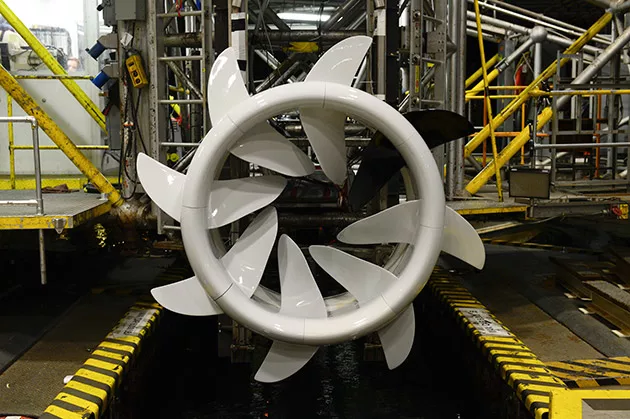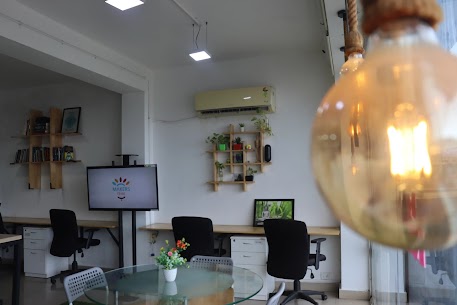Hydrokinetic Turbines are clean renewable energy sources that dramatically minimize carbon emissions from off-grid areas, particularly when diesel fuel is used. Many isolated locations lack access to the electrical power grid and must rely on diesel generators to generate electricity. Most forms of diesel must be imported and stored for lengthy periods, particularly during the winter, which is costly. When compared to diesel generators, using renewable energy devices reduces running time, saves money, reduces CO2 emissions and environmental harm, adds capacity, and generates job possibilities.
For microgrid power systems, hydrokinetic turbines provide a baseload. The system’s mobility eliminates the need for expensive infrastructure. The turbines can be put underwater in floating, fixed, moored, or towed configurations in any location where the effective water flow has a minimum speed of 0.25 m/s.
What are Hydrokinetic Turbines?
Hydrokinetic turbines, a type of renewable energy equipment, provide a way to harness the energy of moving water without the use of traditional hydroelectric structures such as dams and penstocks. Hydrokinetic technologies are being developed for use in natural streams such as rivers, ocean currents, and tidal estuaries, as well as some man-made canals and waterways.
Hydrokinetic turbines can be grouped into multi-unit arrays in ocean-energy structures, which, like a wind farm, can capture energy from tidal and marine currents. The capacity to extract potentially renewable energy resources, such as low-head hydropower and hydrokinetic (HK) power in water flows and waves, has been the focus of efforts to establish new renewable energy sectors and markets. However, only a small percentage of the world’s potential has been accurately exploited or developed.
Low-head hydropower refers to machines that generate energy by transmitting large amounts of water at low pressures (up to 30 meters). Hydrokinetic turbines, like wind turbines, come under the “zero-head” category, in which energy is transferred from the kinetic energy of water flow rather than the potential energy of falling water. Rivers and free-flowing streams can also benefit from hydrokinetic systems. Hydrokinetic energy production avoids many of the issues that typical hydropower units face, such as large civil works costs and the necessity for a potential energy head, by extracting this form of energy. Hydrokinetic turbines are one of the oldest hydropower systems; nonetheless, their evolution may be separated into periods, starting with the waterwheel concept and ending with upgraded pilot plants and experiments. Several hydrokinetic designs, such as river, tidal, and wave energy systems, are advancing technologically today.
Working of Hydrokinetic Turbines
Working HK turbines have basic designs that do not require a reservoir or a spillway. Initial testing indicates that negative environmental consequences are limited, and the designs’ simplicity leads to low-cost installation and maintenance. Because of their simplicity, these systems are useful in rural and distant places. The flow conditions of hydrokinetic turbines are depicted in the diagram below.
Tidal current and river stream are the two basic schemes in which hydrokinetic turbines can be used in power generation systems. In contrast to bidirectional tidal changes, ocean currents provide another possible ocean energy source with a unidirectional flow. Irrigation canals, man-made canals, and industrial outflows are among the other resources.
While all hydrokinetic devices, regardless of their application areas, work on the same principles of energy conversion, there are some distinctions in their designs and operational aspects.
Types of Hydrokinetic Turbines
Here are the most common types of hydrokinetic turbines.
The classification is based on the orientation of the rotational axis in relation to the direction of the water flow.
Turbines with a horizontal axis
The horizontal (axial) axis turbine’s spinning axis is parallel to the flow stream. To ensure optimal power conversion efficiency, the rotor plane is perpendicular to the flow. Horizontal axis turbines, which are extremely similar in idea and design to current wind turbines, are widely used in tidal energy conversion. Horizontal axis turbines are divided into two categories: straight axis turbines and inclined axis turbines.
For modest river energy conversion, inclined axis turbines are commonly used. The VLH (Very Low Head) turbine, an impeller-type turbine utilized at tiny heads (below 5 meters) and high flow rates, is an example of a slanted axis hydrokinetic turbine.
Solid (or stiff) mooring turbines and buoyant mooring turbines are two types of straight axis turbines (including submerged and non-submerged generator turbines). The generator is located near the riverbed or seafloor in solid mooring turbines.
Turbines with Cross-Flow
The rotor axes of cross-flow turbines are parallel to the water surface and orthogonal to the flow. Floating waterwheels are another name for these turbines. These machines are mostly drag-based, and thus are less efficient than their lift-based counterparts. Another issue is the vast amount of material that goes into them. This class of turbines may include Darrieus turbines with cross-flow layouts.
Turbines that rotate vertically
Darrieus, SC- Darrieus, H- Darrieus, Gorlov, and Savonius are examples of vertical axis turbine layouts. Darrieus turbines are the most visible of the vertical axis turbines. Despite the widespread use of H-Darrieus (straight-bladed) turbines in hydro applications, there are no examples of Darrieus (curved or parabolic blades) turbines.
Advantages and Disadvantages of Hydrokinetic Turbines
Hydrokinetic turbines are well-known for their advantages.
However, some of the flaws may be observed, and engineers are continually evaluating and trying to solve them. Some of these advantages and disadvantages are discussed below.
Advantages
- Hydrokinetic turbines can be installed using existing infrastructure without the need for major civil works like dam construction. As a result, construction costs are greatly reduced.
- Hydrokinetic turbines with very low or zero heads are being developed to generate electricity effectively thanks to novel technologies.
- The traditional equivalents’ requirement for a potential hydraulic head is omitted here.
- Where electricity costs in conventional power systems, such as diesel systems, are high, smaller hydrokinetic projects may be a good investment.
- Micro hydrokinetic turbines may be the most cost-effective and dependable option for consumers near running water.
Disadvantages
- Because these turbines rely on the flow of water in pre-existing canals or rivers, they may not be able to function at particular periods of the year or even during specific hours of the day due to flow conditions or available water.
- These turbines can be damaging to the lives of these species because of their rotational structure, their location on the normal course of aquatic migrations, and the noise they emit.
Summary
Hydrokinetic turbines represent a significant advancement in the quest for sustainable and renewable energy sources. By harnessing the natural flow of water currents, these innovative devices offer a promising solution for generating clean energy without the need for large dams or significant environmental disruption. Their ability to operate efficiently in various aquatic environments makes them a versatile option for energy production.
As the technology continues to evolve, hydrokinetic turbines are likely to play an increasingly important role in our energy landscape. With ongoing research and development aimed at addressing current challenges and improving efficiency, the future of hydrokinetic turbines looks bright. Their integration into our energy systems could contribute significantly to reducing our reliance on fossil fuels and mitigating climate change.
Moreover, the integration of advanced technologies such as gas turbine control systems in hybrid energy setups can enhance the overall efficiency and reliability of power generation. By combining the strengths of hydrokinetic turbines with sophisticated control systems, we can optimize energy production and ensure more stable and efficient operations across various energy sources. IS200VTURH1BAA, and IS200VSCAH2ABA are some examples of GE turbine control system spare parts.
In summary, hydrokinetic turbines are not just a technical marvel but also a key player in the transition to a more sustainable and resilient energy future. As we continue to explore and invest in this technology, we move closer to harnessing the full potential of our natural water resources for a cleaner, greener world.



